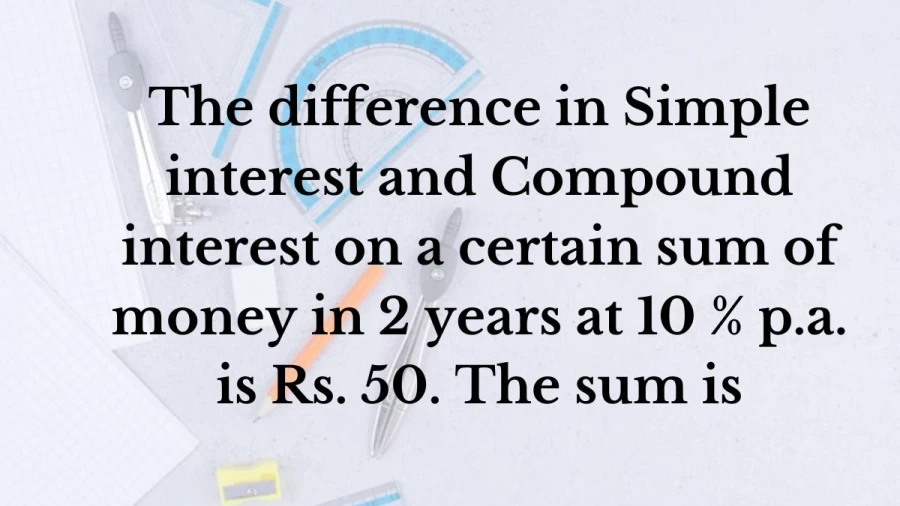If you happen to be viewing the article The difference in Simple interest and Compound interest on a certain sum of money in 2 years at 10 % p.a. is Rs. 50. The sum is? on the website Math Hello Kitty, there are a couple of convenient ways for you to navigate through the content. You have the option to simply scroll down and leisurely read each section at your own pace. Alternatively, if you’re in a rush or looking for specific information, you can swiftly click on the table of contents provided. This will instantly direct you to the exact section that contains the information you need most urgently.
The difference in Simple interest and Compound interest on a certain sum of money in 2 years at 10 % p.a. is Rs. 50. The sum is
To solve this problem, we can use the formulas for simple interest (SI) and compound interest (CI) and then set up an equation to find the principal amount.
Article continues below advertisement
Given:
- Rate of interest (r) = 10% per annum = 0.10
- Time
- Difference between compound interest and simple interest = Rs. 50
The formula for simple interest is: SI = P × r × t
The formula for compound interest is: CI = P × (1 + r/n)^(nt) – P
Where:
- P is the principal amount (the initial sum of money)
- r is the rate of interest (in decimal)
- t is the time the money is invested for
- n is the number of times interest is compounded per time period (in years)
Given that the time period is 2 years and interest is compounded annually, n = 1.
We are given that the difference between compound interest and simple interest is Rs. 50. Therefore, the equation becomes:
CI – SI = 50
Substituting the formulas for CI and SI:
P × (1 + r/n)^(nt) – P – P × r × t = 50
Now, we can plug in the values and solve for P:
P × (1 + 0.10/1)^(1 × 2) – P – P × 0.10 × 2 = 50
P × (1.10)^2 – P – 0.20P = 50
P × 1.21 – P – 0.20P = 50
1.21P – P – 0.20P = 50
0.01P = 50
P = 50/0.01
P = 5000
So, the principal amount (the sum of money) is Rs. 5000.
Simple interest and Compound interest
Both simple interest and compound interest are ways of calculating the interest earned or paid on a loan or investment over time. However, they differ in how the interest is applied:
Article continues below advertisement
Article continues below advertisement
Simple Interest:
- Calculated only on the original principal amount throughout the entire term.
- Interest earned/paid is the same for each period.
- Formula: SI = (P * R * T) / 100
- SI = Simple Interest
- P = Principal amount
- R = Interest rate (as a decimal)
- T = Time period (in years)
Compound Interest:
- Earned/paid on both the original principal and the accumulated interest from previous periods.
- Interest grows exponentially over time due to “interest on interest” effect.
- Formula: A = P * (1 + R/n)^(n*T)
- A = Amount (final value)
- P = Principal amount
- R = Interest rate (as a decimal)
- n = Number of compounding periods per year (e.g., monthly = 12)
- T = Time period (in years)
Here’s a table summarizing the key differences:
| Feature | Simple Interest | Compound Interest |
|---|---|---|
| Calculation base | Original principal only | Original principal + accumulated interest |
| Interest growth | Linear | Exponential |
| Formula | SI = (P * R * T) / 100 | A = P * (1 + R/n)^(n*T) |
| Suitable for | Short-term investments/loans | Long-term investments/loans |
Example:
Let’s compare the interest earned on a $10,000 investment at 5% interest for 5 years:
- Simple Interest: SI = (10000 * 0.05 * 5) / 100 = $2500
- Compound Interest (assuming annual compounding): A = 10000 * (1 + 0.05)^(1*5) = $12762.82
Thank you so much for taking the time to read the article titled The difference in Simple interest and Compound interest on a certain sum of money in 2 years at 10 % p.a. is Rs. 50. The sum is written by Math Hello Kitty. Your support means a lot to us! We are glad that you found this article useful. If you have any feedback or thoughts, we would love to hear from you. Don’t forget to leave a comment and review on our website to help introduce it to others. Once again, we sincerely appreciate your support and thank you for being a valued reader!
Source: Math Hello Kitty
Categories: Math

